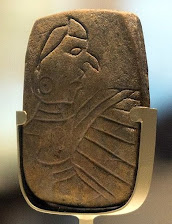 |
| Cahokia |
CahokiaDuring its apex -- approximately between the years 1050-1200 -- there was a huge city located near present-day St. Louis whose population, including nearby districts, eventually reached 40,000-50,000 -- larger than London at that time. In fact, it had been the largest city north of the Aztecs until Philadelphia in the 1780's, around the time of the American Revolution. Even Chicago did not eclipse that population until after 1850, more than 6 centuries later. Researchers do not know which people built the city, although they are believed to be Mississippians, who had populated the area between 800-1600. No one even knows what the city was called -- it is presently referred to as Cahokia, but that is taken from a tribe that had temporarily dwelt in the area after the Mississippians. The largest structure of the city, Monks Mound (see below), is named after some French Trappist Monks who lived atop the mound in the early 1800's. The city builders left no writings, and no one knows what language they spoke.
Monks Mound
 |
| Monks Mound Depiction |
The centerpiece of the city was a soil/clay mound 30 m (100 ft) high, as tall as a modern 10-story building. The base of the mound covered about 70,000 m² (over 750,000 ft²), about 15 acres -- a larger area than the base of the Egyptians' Great Pyramid of Giza, and the perimeter is larger than the Aztecs' Pyramid of the Sun at Teotihuacan. The mound had begun around the year 900, and more material had been added over the course of 300 years. A large building was believed to have been erected on top of the mound, although its purpose has yet to be clarified. The edifice covered over 460 m² (5,000 ft²) and has been calculated to have been as high as 5-story building.The Rest of the City
 |
| Cahokia Birdman Tablet |
There were scores of smaller earthen mounds throughout the city and in the surrounding districts. Much of the central city had been protected by wooden bulwarks -- about 15,000 clay-covered logs had been used to create a wall 2 miles in circumference. Logs had also been used in a number of areas to create "woodhenges," tall posts that corresponded with the positions of the Sun and Moon. Some pottery pieces and carvings exist from the civilization, and there are remains of a copper plant, but not enough artifacts have yet been discovered to conclude what kind of culture was in place. There is evidence, however, of torture, live burials, decapitations, and human sacrifices, so these people were not just simple farmers and merchants. Or maybe they were, but with some questionable fetishes. |
| Replication of Cahokia City Wall |
The civilization apparently collapsed around 1350 for unknown reasons, although there is speculation regarding a breakdown in food productivity because of drought and related events. Of course, another reason might be that the human sacrifice thing was not an effective motivator for long-term residence.
 |
| Cahokia Figurine |
Cahokia is presently the largest archeology site in the United States. However, its existence has always been rather understated -- a detailed account of it wasn't even written until 1811, and serious excavations did not begin until the 1960's. And those excavations began only because two different interstate highways were slated to cut through the area (and they eventually did). It is surmised that one of the reasons for the lack of interest in the site is that the fact of "Indians'" settling in one place for centuries, and building a city that rivaled the size of American cities built hundreds of years later by mostly European descendants just doesn't fit into the new Americans' stereotypical concept of the indigenous peoples. It is estimated that only 1% of Cahokia has been excavated, so there might be some more surprises upcoming.





No comments:
Post a Comment